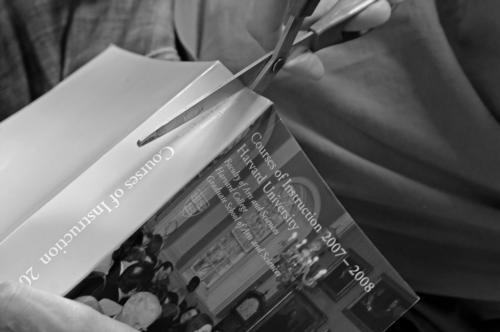
News
Summers Will Not Finish Semester of Teaching as Harvard Investigates Epstein Ties

News
Harvard College Students Report Favoring Divestment from Israel in HUA Survey

News
‘He Should Resign’: Harvard Undergrads Take Hard Line Against Summers Over Epstein Scandal

News
Harvard To Launch New Investigation Into Epstein’s Ties to Summers, Other University Affiliates

News
Harvard Students To Vote on Divestment From Israel in Inaugural HUA Election Survey
Shuffling the Deck

Picture a pack of playing cards sorted into suits. Shuffle the cards together and deal them out into new piles, but imagine that cards with similar affinities will gravitate toward each other. The original suits will exert some pull, but cards of like denominations might also attract one another. Perhaps face cards will form a group, or even red-card black-card societies. If subtle affinities like these are allowed to play a role during the deal, what is the likelihood that you’ll deal out the original suits?
Now think about the faculty of this university as an enormous stack of cards, a thousand in FAS alone. The cards are currently sorted into decks of varying sizes. Departments like English and Economics form some decks. Others correspond to the professional schools, such as HLS and HMS. Reshuffle these decks, and allow the faculty to form new groupings based on what they currently regard as their strongest and most exciting affinities. What is the likelihood that they will sort themselves into the original departments and schools?
To answer this, we need some history. Today’s departments didn’t always exist in their current form. Most of them coalesced late in the nineteenth century, as many U.S. universities shed their religious underpinnings and picked up the German style of higher education. Departments, in turn, were linked to the emergence of modern disciplines. It’s easy to track the founding of disciplines. Just check the date of the major academic journals: the Political Science Quarterly (founded 1886), American Anthropologist (1888), The American Historical Review (1895), and so on. Departments were invented to house and administer the research and teaching profiles of the new disciplines.
Fast-forward to the present. Now, in 2009, we’re operating within an intellectual structure that took shape more than a century ago. It’s a worthy and venerable old edifice, but definitely getting a bit creaky. The oddity of departmental existence struck me forcefully this year as I watched my three freshmen advisees grapple with the tough question of concentration choice. Some students, upon comparing their academic inclinations with the concentration offerings, are able to slide easily into a field. But others cannot, because the fit doesn’t seem right.
Departments and schools are a necessary administrative device, and in some cases the original logic of disciplines and departments is powerful and worth preserving. But as the recent restructurings of biology and anthropology have suggested, a century-old logic is not necessarily a logic that best promotes research, teaching, and inquiry. For many faculty, our current departments reflect only a part of our intellectual and teaching horizons. Much the same is true for our students, as I learned this year.
So if the decks were reshuffled, wholly new departments might emerge: a department of evolutionary studies, say, or perhaps a department of cognition and neurobiology which would unite professors from the sciences with those involved in the arts and humanities. The possibilities are endless.
The idea of reshuffling the decks has considerable appeal. But here’s the conundrum: the act of forming new institutions does not, ipso facto, solve the problem of institutional exhaustion. So rather than form new departments that would just calcify in their turn, we want a device that would allow us to fold in the hands every few years and reshuffle the decks.
In point of fact, the world of research is already abuzz with ideas and devices for pulling faculty out of their departmental homes into temporary alliances with other disciplines. Centers like the Radcliffe Institute fund one-time-only interdisciplinary research seminars. Funding organizations provide research funds with sunset clauses, ensuring that collaborations end every few years. In the world of research, in short, there exist devices for reshuffling faculty. The time has come to bring this same philosophy to the world of teaching.
Obviously, there has to be a certain amount of continuity in our courses and curricula. But not every facet of the curriculum has to be imagined as permanent. For example, why not create a rolling series of secondary fields each with built-in sunset clauses, lasting no more than three or four years? These fields could be organized around a set of innovative, one-time-only freshmen seminars, Gen Ed courses, and departmental courses, each targeting a problem that energizes faculty and students alike. Courses could even be linked to short-term interdisciplinary and cross-faculty research projects. If a field lingered beyond its days as a secondary field, fine. But a lot of us would be just as happy to learn and move on.
Even within existing departments, courses and curricula do not have to aim for permanence. I could easily imagine a small group of faculty in my department joining together to offer temporary tracks or plans of study centered on powerful themes—human rights, the deep history of slavery, economic catastrophes—that take form as courses, seminars, public lectures, and even thesis projects.
We already shuffle our decks repeatedly in pursuit of new research initiatives. Can’t we do the same for our courses and curricula?
Daniel L. Smail is Professor and Director of Undergraduate Studies of History at Harvard.
Want to keep up with breaking news? Subscribe to our email newsletter.
